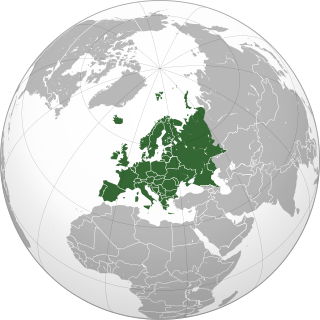
Intelsat 603 or IS-603, previously named Intelsat VI F-3, is a communications satellite operated by Intelsat. Launched in 1990, it was the second of five Intelsat VI satellites to be launched. The Intelsat VI series was constructed by Hughes Aircraft, based on the HS-389 satellite bus.
Intelsat 15, also known as IS-15, is a communications satellite owned by Intelsat. Intelsat 15 was built by Orbital Sciences Corporation, on a Star-2.4. It is located at 85° E longitude on the geostationary orbit. It was launched from Baikonur Cosmodrome to a geosynchronous transfer orbit on 30 November 2009 by a Zenit-3SLB launch vehicle. It has 22 active Ku band transponders, plus eight spares. Five of those transponders are owned and operated by SKY Perfect JSAT Group under the name JCSAT-85.
Intelsat 601, previously named Intelsat VI F-1, was a communications satellite operated by Intelsat, and later Europe*Star. Launched in 1991, it was the last of five Intelsat VI satellites to be launched. The Intelsat VI series was constructed by Hughes Aircraft, based on the HS-389 satellite bus.
Intelsat 602, also known as IS-602 and previously named Intelsat VI F-2, is a communications satellite operated by Intelsat. Launched in 1989, it was the first of five Intelsat VI satellites to be launched. The Intelsat VI series was constructed by Hughes Aircraft, based on the HS-389 satellite bus. As of 2012, Intelsat 602 remains operational.
Intelsat 604, previously named Intelsat VI F-4, was a communications satellite operated by Intelsat. Launched in 1990, it was the third of five Intelsat VI satellites to be launched. The Intelsat VI series was constructed by Hughes Aircraft, based on the HS-389 satellite bus.
Intelsat 605, previously named Intelsat VI F-5, was a communications satellite operated by Intelsat. Launched in 1991, it was the fourth of five Intelsat VI satellites to be launched. The Intelsat VI series was constructed by Hughes Aircraft, based on the HS-389 satellite bus.
The JSAT constellation is a communication and broadcasting satellite constellation formerly operated by JSAT Corporation and currently by SKY Perfect JSAT Group. It has become the most important commercial constellation in Japan, and fifth in the world. It has practically amalgamated all private satellite operators in Japan, with only B-SAT left as a local competitor.
Intelsat 33e, also known as IS-33e, is a high throughput geostationary communications satellite operated by Intelsat and designed and manufactured by Boeing on the BSS-702MP platform. It is the second satellite of the EpicNG service, and will cover Europe, Africa and most of Asia from the 60°East longitude, where it is expected to replace Intelsat 904. It has a mixed C band, Ku band and Ka band payload with all bands featuring wide and C and Ku also featuring spot beams.
Intelsat 29e, also known as IS-29e is a high throughput geostationary communications satellite designed and manufactured by Boeing on the BSS-702MP platform. It is the first satellite of the EpicNG service, and covers CONUS, Latin America and North America from the 50° West longitude, where it is replaced Intelsat 1R. It also replaced Intelsat 805 which was moved from 56.5° West to 169° East. It has a mixed C band, Ku band and Ka band payload with all bands featuring wide and the Ku also featuring spot beams.
Intelsat 701 is a geostationary communication satellite that was built by Space Systems/Loral (SSL). It is located in the orbital position of 32.9 degrees east longitude and it is currently in an inclined orbit. The same is owned by Intelsat. The satellite was based on the HS-601 platform and its estimated useful life was 15 years.
Intelsat 704 is a geostationary communication satellite that was built by Space Systems/Loral (SSL). It is located in the orbital position of 29.5 degrees east longitude and it is currently in an inclined orbit. The same is owned by Intelsat and after sold to SES World Skies on November 30, 1998. The satellite was based on the LS-1300 platform and its estimated useful life was 15 years.
Intelsat 706 is a geostationary communication satellite that was built by Space Systems/Loral (SSL). It is located in the orbital position of 157 degrees east longitude and it is currently in an inclined orbit. The same is owned by Intelsat. The satellite was based on the LS-1300 platform and its estimated useful life was 15 years.
Intelsat 801 is a geosynchronous communications spacecraft that was launched on March 01, 1997 by an Ariane 44L rocket from Kourou in French Guiana to provide voice and video communications to the member countries in that consortium after parking at 174° E longitude. It carries 38 C Band and 6 Ku Band transponders. It was built for US$76 million, launched for US$86 million and insured for US$27 million.
Intelsat 802 was a communications satellite operated by Intelsat. Launched in 1997 it was operated in geostationary orbit at a longitude of 174 degrees west for around fourteen years.
Intelsat 804 was a communications satellite operated by Intelsat. Launched in 1997 it was operated in geostationary orbit at a longitude of 44 degrees east for around 8 years.
Intelsat 903 is a communications satellite operated by Intelsat.
Intelsat 904 is a communications satellite operated by Intelsat.
Intelsat 905 is a communications satellite operated by Intelsat.
Intelsat 906 is a communications satellite operated by Intelsat.
Intelsat 907 is a communications satellite operated by Intelsat.




